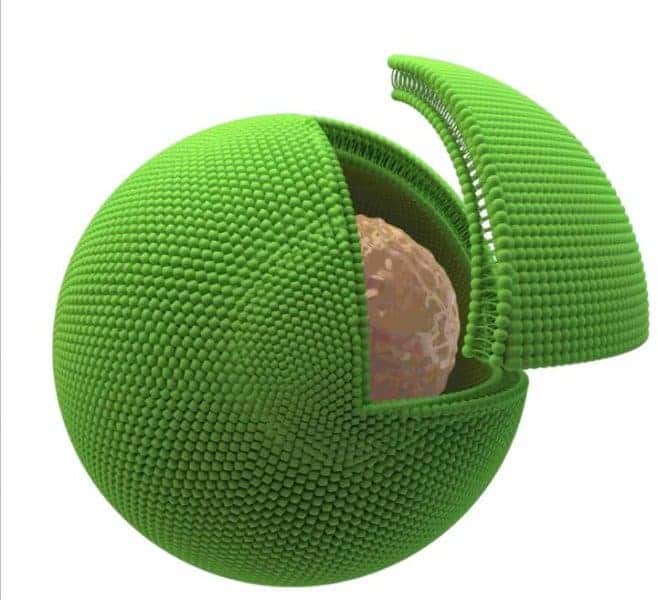Researchers from the Imperial College London (ICL) have fused living and non-living cells for the first time; the new entities should allow us to cash in on the abilities of living organisms in harsh applications traditionally relegated to machines.

An impression of a biological cell (brown) inside the artificial cell (green).
Image credits Imperial College London.
The system encapsulates biological cells within an artificial cell-like casing that allows the two to work together. The system should allow researchers to draw on the natural abilities of biological cells while keeping them safe from environmental threats. For example, the cyborg cells could be used as photosynthesis ‘batteries’, as in-vivo drug factories swimming around your bloodstream, or as biological sensors that can operate in harsh environments.
Rise of the cellborgs
The idea of mixing biological and mechanical systems isn’t new. However, previous work focused on taking part of a cell’s systems, such as certain enzymes or chemical processes, and grafting them into artificial casings. The work at ICL stands out by being the first to take an entire cell and put it in a mechanical shell.
A shell it may be, but it’s far from being just a shell: the artificial component also contains enzymes that work together with those inside the cell to produce new compounds. In the proof-of-concept experiment, the artificial shell produced a fluorescent chemical that allowed the researchers to confirm all was working as expected.
Biological cells can perform extremely complex functions, but can be difficult to control when trying to harness one aspect, says lead researcher Professor Oscar Ces, from the Department of Chemistry at ICL. “Artificial cells can be programmed more easily but we cannot yet build in much complexity.”
“Our new system bridges the gap between these two approaches by fusing whole biological cells with artificial ones, so that the machinery of both works in concert to produce what we need. This is a paradigm shift in thinking about the way we design artificial cells, which will help accelerate research on applications in healthcare and beyond.”
The team called on a field of knowledge known as microfluidics — which details the behavior of fluids through small channels — to put the two together. They used water and oil (which don’t mix) to make droplets of a defined size that contained both the cells and enzymes. Then, they applied a protective coating on the droplets, creating the artificial shell.
These cellborgs (not an official term, sadly) were then placed in a concentrated copper solution, since copper is usually toxic to biological cells. The team was able to detect the fluorescent chemicals in most of them after immersion, meaning the biological cells were safe inside their shells, still alive and functioning. This ability suggests the bio-artificial cells would be useful in the human body, where foreign biological cells have to contend with attacks by the body’s immune system.
The team went on to explain that their system is “controllable and customizable,” and that they can create different sizes of artificial cells. Furthermore, the casings can be applied to a wide range of cellular machinery “such as chloroplasts for performing photosynthesis or engineered microbes that act as sensors.”
Next on the list is improving the cellborgs’ functionality by improving the artificial shell, in order to make it act more like a biological membrane with extra functions. For example, if it could be designed to open and release the chemicals produced within only in response to certain signals, the cells could be used to deliver drugs to specific areas of the body. This would allow for greater drug efficiency with fewer side-effects — particularly useful for diseases such as cancer.
There’s still have a lot of work to do to get there, but the team says they’ve made a few promising steps in the right directions.
The paper “Constructing vesicle-based artificial cells with embedded living cells as organelle-like modules” has been published in the journal Scientific Reports.









